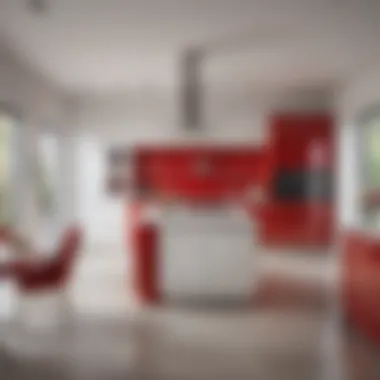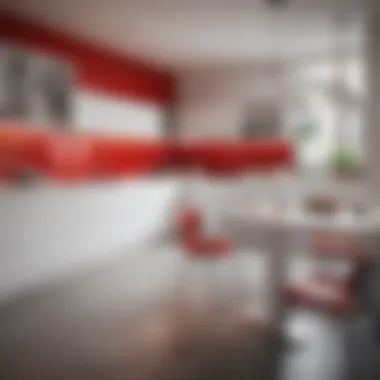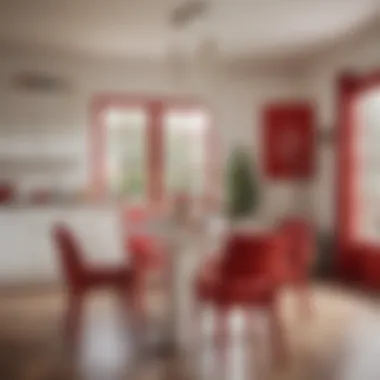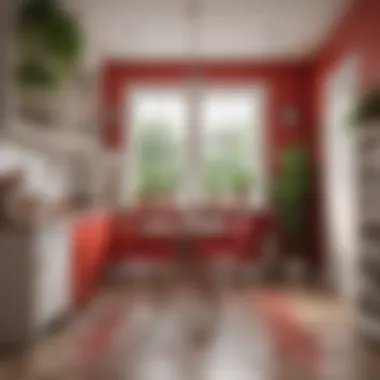Red and White Kitchen Decor: Design Insights and Tips


Intro
The choice of colors in kitchen decor significantly influences both the mood of the space and the functionality of the area. Red and white are two colors that can coexist beautifully, presenting not just aesthetic charm but also practical advantages. Red is a powerful color often linked to energy, passion, and warmth. In contrast, white signifies purity, cleanliness, and openness. Together, these colors can create an inviting and stimulating environment that enhances the culinary experience.
In this article, we will explore the design principles and practical applications of red and white kitchen decor. Homeowners and interior design enthusiasts will find insights on trending styles, color palettes, and essential maintenance tips. Our focus will be on merging aesthetic appeal with functionality while ensuring that these color choices resonate with personal preferences and current design trends.
Understanding Color Theory in Kitchen Design
Understanding color theory is fundamental when designing any space, especially the kitchen. The kitchen is often seen as the heart of the home, and red and white combinations can yield both aesthetic beauty and functional efficiency. This section will discuss how color choices influence mood, perceptions, and even social dynamics, ultimately shaping the cooking and dining experience.
The Psychological Effects of Red and White
Emotional responses to red
Red is a powerful color associated with energy and passion. Its vibrant hue can evoke strong emotional responses. In the kitchen, red might stimulate appetite and creativity. Many restaurants utilize red in their decor for this reason. Choosing red elements, such as accents or appliances, can create an inviting atmosphere, encouraging family gatherings and culinary adventures. However, excessive use may also lead to feelings of irritation or aggression. Therefore, moderate integration, such as in an accent wall or decorative items, often achieves a better balance.
Associations with white
White embodies concepts of purity and simplicity. In kitchen design, it conveys a sense of cleanliness and openness. White surfaces can enhance natural light, making the room feel spacious. As a versatile color, white can pair harmoniously with bold reds, creating a striking contrast. However, it may require more maintenance to keep clean, as stains and smudges become more pronounced. Still, the benefits of brightening and expanding a space often outweigh the drawbacks of upkeep.
Cultural context of color usage
Cultural perceptions of color shape how people view red and white in kitchen spaces. In many Western cultures, red symbolizes excitement and passion; while white represents cleanliness and peace. Asian cultures may regard red positively, associating it with good fortune and happiness. Considering these cultural contexts can guide design choices to create kitchens that resonate emotionally with users. Employing colors according to cultural significance can enhance the kitchen's atmosphere, ensuring it feels welcoming and relatable.
Color Harmony and Balance
Creating contrast
Creating contrast is essential for visual interest in kitchen design. Red and white, when used together, provide a dynamic juxtaposition. Red offers warmth while white introduces clarity. Using these colors effectively can delineate different areas of the kitchen, such as separating the dining zone from the cooking space. Achieving this contrast helps draw attention to key elements, such as cabinetry or countertops. However, strong contrasts must be applied thoughtfully to avoid overwhelming the senses.
Achieving visual balance
Incorporating red and white requires a keen sense of balance. Too much of one color can dominate the space and detract from the overall aesthetic. Equal distribution of red and white elements helps maintain harmony, ensuring the kitchen remains inviting and balanced. This can be accomplished through strategic placement of accessories or by choosing appliances in both colors. Visual balance encourages movement flow and makes the kitchen more functional and pleasant.
Combining textures and patterns
In blending textures and patterns, red and white create richness in design. Pairing smooth white surfaces with textured red elements, such as a woven table runner or a brick backsplash, adds depth to the kitchen. Consider using various patterns, like checkered or striped textiles, for curtains or linens. This strategy can create a cohesive yet engaging look. However, it is important to avoid excessive patterns that can create visual noise, leading to a cluttered feel.
"Color is the keyboard, the eye is the hammer, and the soul is the piano with many strings." —Wassily Kandinsky
Design Styles Featuring Red and White
The design styles that incorporate red and white play a crucial role in the overall aesthetic of kitchen decor. These two colors can either complement or contrast with each other, depending on how they are used. Knowing which style works best can guide homeowners in creating a functional and visually appealing kitchen. Red often brings warmth and energy, while white suggests cleanliness and simplicity. Together, they can establish a balanced environment that caters to both comfort and design principles.
Scandinavian Minimalism
Key features of Scandinavian design
Scandinavian design emphasizes simplicity, functionality, and minimalism. It features clean lines, a lack of clutter, and a focus on natural materials. The use of wood is prominent, along with a light color palette dominated by whites and light grays. One of the main benefits of such design is its ability to create a calm atmosphere. By utilizing red and white, a kitchen can maintain this tranquil vibe while adding pops of color through red accents. This makes it a strong choice for those looking for a refined yet inviting space.
Utilization of red and white in minimalism


The utilization of red and white within the framework of Scandinavian minimalism highlights the need for color to enhance simplicity. In this style, red can be incorporated through kitchen accessories, such as dishware or textiles, while white typically dominates walls and cabinetry. The key characteristic of this approach is its effectiveness in keeping the kitchen bright and airy, all while introducing warmth. Minimalism allows homeowners to express individuality without overwhelming the space with color, making it a popular choice for kitchen designs.
Traditional and Rustic Styles
Elements of traditional decor
Traditional decor tends to emphasize classic design elements and intricate details. It often combines natural materials with rich textures, creating a sense of warmth. In a traditional kitchen, red may appear in the form of painted cabinets, while white might be used for backing or wall colors. The benefit of this style includes a timeless appeal that resonates well with many homeowners. Additionally, it creates a cozy atmosphere which can be inviting for family and friends alike.
Integrating farmhouse aesthetics
Farmhouse aesthetics marry rustic charm with functional design. This style often incorporates bold red accents, such as in cabinetry or furniture, against a backdrop of white walls or open shelving. The stark contrast enhances the feeling of openness in the kitchen while contributing to a rustic look. Integrating farmhouse aesthetics offers an opportunity to create a welcoming kitchen environment, where simplicity meets style, and everyday activities are enjoyed in comfort.
Contemporary and Modern Designs
Sleek lines and bold statements
Contemporary and modern designs feature a strong focus on sleek lines and the bold juxtaposition of colors. Here, red is often used as a statement color in a minimalistic way—think red stools against white countertops or backsplashes. The key characteristic of this style is its ability to provide a striking visual impact while keeping the atmosphere sophisticated. Homeowners who aim for modern kitchen designs benefit from this style as it allows for creativity without sacrificing elegance.
Use of innovative materials
The use of innovative materials like stainless steel and engineered stone complements the contemporary design of kitchens featuring red and white. Such materials add a modern flair and durability to kitchen spaces. The merging of red and white through these materials creates a balance of warmth and coolness. This aspect makes them a beneficial choice for high-traffic kitchens, ensuring that the space remains functional while being visually cohesive.
Materials and Textures
In the realm of kitchen decor, materials and textures play a crucial role in achieving a cohesive and inviting space. This section examines the various components that contribute to the overall aesthetics and functionality of a red and white kitchen. Choosing the right materials ensures that the design aligns with both practical needs and style preferences. The textures of these materials can create depth and warmth, transcending a simple color scheme and making it truly captivating.
Paint and Finishes
Choosing the right paint type
When it comes to selecting paint for a kitchen, the choice of type is significant. Oil-based paints are often favored for their durability and washability, making them ideal for high-traffic areas like kitchens. They resist moisture, which is essential in spaces prone to spills and humidity. A key characteristic of oil-based paint is its shiny finish, which can enhance the visual appeal of red and white decor.
However, water-based paints have gained popularity due to their ease of cleaning and low VOC (volatile organic compounds) emission. This makes them a healthier choice for indoor air quality. The unique feature of water-based paint is its quick drying time, enabling faster project completion. In summary, both types have their advantages, but discerning homeowners may lean towards one based on personal preference and environmental considerations.
Finish options for durability
The finish of paint plays an important role in maintaining the kitchen's overall look and feel. Gloss or semi-gloss finishes are particularly suitable for kitchen interiors. They provide a shiny surface that is easy to wipe clean, effectively combating the daily wear and tear that kitchens endure.
A common challenge is balancing aesthetics and pragmatism. While a matte finish offers a modern, chic look, it can be less forgiving when it comes to stains. Therefore, opting for a durable finish enhances the longevity of the decor, ensuring that it remains attractive over time. When choosing finishes, consider that durability contributes significantly to the maintenance of the vibrant red and crisp white palette.
Fabrics and Upholstery
Selecting textiles for kitchen chairs
Textiles impart comfort and warmth to a kitchen's ambiance. Selecting the right fabric for kitchen chairs is essential for both functionality and style. Durable materials, such as canvas or synthetic fibers, withstand spills and regular use, making them practical choices. The texture also adds an inviting aspect to the decor.
A key characteristic of upholstery fabric is its ability to complement the red and white color scheme. Bold prints or simple patterns can enhance visual interest while maintaining cohesiveness. Options like stain-resistant treatments can offer longer life spans to upholstery while simplifying maintenance. In the end, selecting textiles is not just about color but also about practical wear should make a significant point of consideration for homeowners.
Window treatment fabric choices
Window treatments are elements often overlooked, yet they harmonize the decor of a kitchen effectively. Fabric choices for window treatments can vary from light filtering to blackout options. Lightweight fabrics like sheer linen or cotton in white complement the red accents, offering an airy feel while allowing natural light.


On the other hand, heavier materials like velvet can provide a rich contrast, creating depth and warmth. Choosing a fabric that aligns with the kitchen's style and functionality ensures that it enhances but does not distract from the overall design intent.
Countertops and Cabinets
Popular materials for surfaces
Countertops and cabinets form the backbone of kitchen design. Therefore, selecting popular materials is vital in a red and white kitchen. Quartz, for instance, offers durability and aesthetic variety, suitable for busy kitchens. Its non-porous nature resists stains, which benefits the visual appeal.
Another popular option is butcher block, which can add warmth through its natural wood texture while maintaining the color scheme with white cabinetry. However, it requires regular maintenance like oiling to prevent wear. The choice of material impacts not just the aesthetics but also the longevity and usability of kitchen surfaces.
Color coordination techniques
Color coordination is instrumental when harmonizing the elements in kitchen design. A red and white kitchen can benefit from specific techniques. For instance, using different shades of red can create a layered effect, adding depth to overall decor. Contrasting textures can provide an engaging visual experience.
Using white cabinets against red countertops can make them stand out prominently, creating an elegant focal point. Homeowners should also consider the synergy between different materials and colors to ensure there is a seamless blend without overwhelming starkness. Effective color coordination creates a balanced composition, accentuating the beauty of the red and white palette.
Decorative Elements and Accessories
Decorative elements and accessories play a significant role in kitchen design, especially when working with the bold palette of red and white. These components are not just functional; they elevate the aesthetic quality of a space. Carefully chosen decorations can harmonize the two colors, creating an inviting and cohesive atmosphere. The thoughtful integration of accessories reflects personal style while enhancing the overall theme of the kitchen.
Appliances and Fixtures
Choosing red or white appliances
Selecting appliances in red or white can be a transformative decision for your kitchen. Red appliances can become a striking focal point, exuding energy and warmth. They stand out against neutral backgrounds and can complement white cabinetry well.
On the other hand, white appliances promote a clean and classic look. This choice is versatile and tends to blend seamlessly with various design styles. Both options come with advantages. Red appliances are attention-grabbing, which is appealing to those looking for energy in their space. Meanwhile, white appliances may offer a timeless aesthetic, which can help maintain a light and airy feel in the kitchen.
Coordination with overall decor
The way appliances coordinate with the overall decor is crucial in creating a cohesive kitchen design. When choosing appliances, consider the existing elements in your kitchen such as cabinetry, countertops, and wall colors. Appliances should complement these elements to promote harmony and balance.
For example, red appliances will mesh well with white cabinets, creating a striking contrast while maintaining elegance. Alternatively, sticking with white appliances could enhance a minimalist or subtle design. This decision impacts not only aesthetics but functionality too, ensuring that the kitchen's rhythm is not disrupted.
Wall Art and Decor
Using art to enhance color themes
Art has the power to significantly uplift the mood and aesthetic of a kitchen. Using art to enhance color themes can bind the visual elements of a space. Red and white art pieces can be particularly effective in reinforcing the color scheme.
Paintings, prints, or even sculptures that incorporate these colors can add depth and interest to walls. Furthermore, they offer an opportunity for personal expression. This integration ensures that the kitchen remains not just a place for cooking, but also a gallery of individual tastes and preferences.
Placement strategies for maximum effect
Placement strategies are essential for ensuring that art and decor have the desired impact. Key factors include visibility, scale, and proximity to other decor elements. Positioning artwork at eye level generally creates the best visual interaction. Additionally, art should not compete for attention with appliances or fixtures; instead, it should harmonize with them.
Effective placement can create focal points within the kitchen. For instance, hanging a large art piece above a dining table draws the eye and invites engagement, making it a pivotal part of the kitchen’s design narrative.
Tableware and Cookware
Integrating color into dining elements


Integrating color into dining elements enhances the overall visual narrative of the kitchen. Red and white tableware can create a seamless flow between the kitchen and dining area. This continuity reinforces the color theme while also adding charm to dining experiences.
Using red or white dishes, glasses, and utensils can elevate meal presentation. For design enthusiasts, matching cookware with the kitchen's theme creates an inviting atmosphere. Such details signify thoughtful design, highlighting the intention behind every aspect of the kitchen.
Selecting complementary pieces
Choosing complementary tableware is crucial to create a unified look. This involves selecting colors and patterns that harmonize with the red and white scheme. Consider dishes that incorporate both colors or feature soft patterns that blend well.
Complementary pieces should enhance the visual connection, linking table settings to the kitchen decor. This kind of consideration helps maintain visual coherence throughout your kitchen space. Moreover, it allows for creative expression while keeping a structured design aesthetic.
Practical Implementation Tips
In the realm of kitchen design, practical implementation tips hold significant weight. These tips guide homeowners toward creating a red and white kitchen that is not only visually distinctive but also functional. Understanding how to plan effectively, add personal touches through DIY projects, and maintain surfaces enhances the design experience. Each element contributes to achieving a harmonious space where aesthetic appeal meets everyday practicality.
Planning Your Design
Assessing kitchen space
Assessing the kitchen space is a critical aspect when planning the design. It involves determining the dimensions and layout before making decisions. This is important because an accurate assessment will help in utilizing red and white decor effectively without overwhelming the area. An ideal choice is to measure cabinets, countertops, and pathways. Knowing the dimensions allows for better placement of furniture and fixtures. This results in an organized and accessible kitchen, reducing clutter and boosting functionality.
Creating mood boards for inspiration
Creating mood boards for inspiration is an effective tool for visualizing the intended design. Mood boards can showcase color combinations and styles in a cohesive manner, helping to clarify ideas. This approach is beneficial because it enables homeowners to experiment with different patterns and textures before making final decisions. The unique feature of a mood board lies in its flexibility. It can be a physical collage or a digital collection, giving freedom in representation. This practice can lead to insightful choices but requires thoughtful selection to avoid overwhelming visual clutter.
DIY Projects for Personal Touch
Simple DIY decor ideas
Simple DIY decor ideas support the personal touch in kitchen design. These projects often require minimal materials but yield significant value. Ideas such as painting cabinet doors or creating custom wall art allow for individual expression while adhering to a red and white theme. This approach is popular as it is often cost-effective and encourages creativity. The emphasis on customization makes each piece unique. However, time and skill level may pose a challenge, potentially deterring some homeowners from taking on such projects.
Upcycling existing kitchen items
Upcycling existing kitchen items contributes a sustainable aspect to the decor process. This practice involves repurposing old items, like turning an unused stool into a unique plant stand. By integrating upcycled elements, homeowners can maintain the red and white color scheme while promoting environmental consciousness. A major advantage of upcycling is cost savings, providing creative solutions to budget constraints. However, the challenge lies in ensuring that the final product fits harmoniously within the desired aesthetic, requiring careful consideration in design choices.
Maintenance and Care
Cleaning techniques for red and white surfaces
Cleaning techniques for red and white surfaces are essential to preserve the kitchen's aesthetic. White surfaces, in particular, can show marks and stains more easily, thus requiring specific approaches. Using mild detergents or vinegar can help maintain cleanliness without damaging finishes. This section is crucial as it provides practical ways to ensure longevity of decor choices. While the techniques are straightforward, they demand regular attention to maintain a pristine appearance.
Preventing color fading and wear
Preventing color fading and wear is important for sustaining the visual impact of red and white decor over time. Direct sunlight can cause colors to lose their vibrancy. Using curtains or blinds can shield surfaces but this alone is not enough. Regular maintenance, such as polishing surfaces, is also necessary. This aspect stands out as it addresses the longevity of investment in decor. Adopting these measures can result in a kitchen that looks fresh and inviting for years. On the downside, some preventative techniques may require more effort than homeowners anticipate.
End: The Timeless Appeal of Red and White
Red and white as a color combination carries significant weight in kitchen decor. It symbolizes both energy and purity. These colors not only affect mood but also reflect individual personality within the space. Homeowners and design enthusiasts can benefit from understanding how these colors perform in their kitchens.
The appeal of red and white manifests in various ways. Red often radiates warmth. It stimulates appetite and promotes a lively atmosphere. In contrast, white offers a clean and fresh feel. It can create an illusion of space, making kitchens appear larger and more open. Therefore, balancing these two colors can result in a visually captivating environment that maintains practicality.
When it comes to implementation, the red and white palette provides great versatility. One can encapsulate charm through classic farmhouse styles or project a modernized aspect through sleek design. Achieving this requires a keen eye for detail and the ability to merge styles without overwhelming the senses.
It is important to consider the types of materials and textures used with these colors. For instance, pairing a matte red finish with glossy white can create interesting contrasts. Adding textures can further elevate the design, making it more inviting.
"Color is not just what you see, it is a reflection of who you are."
Moreover, the longevity of this color duo is noteworthy. Trends may shift, but red and white often remain staples in kitchen design. They hold a timeless quality that transcends fleeting fads. Homeowners can rest assured knowing their choice will endure beyond current decor trends.







